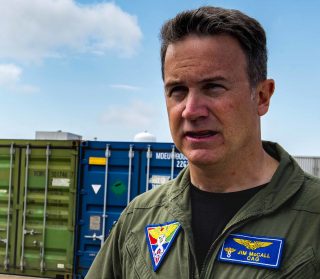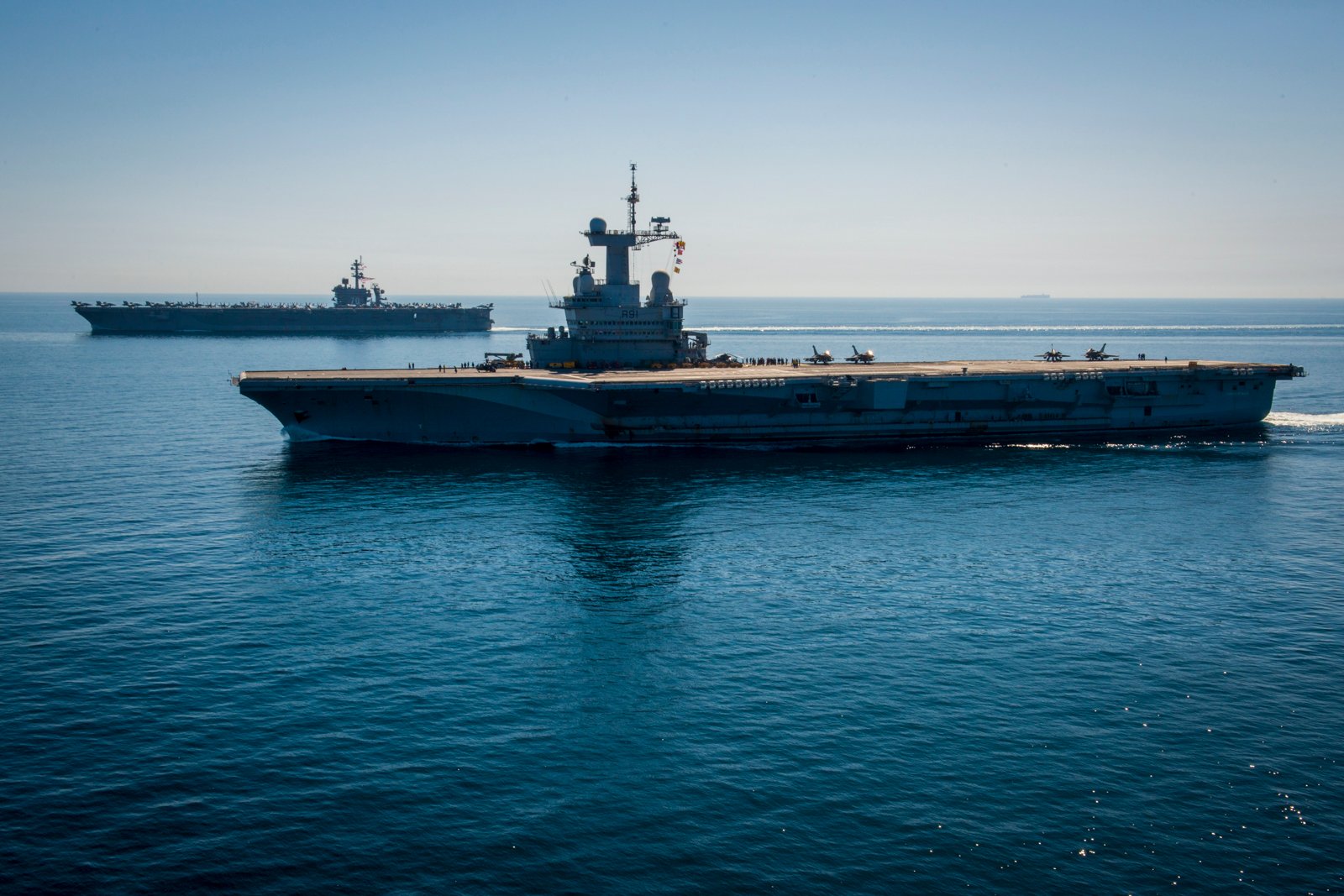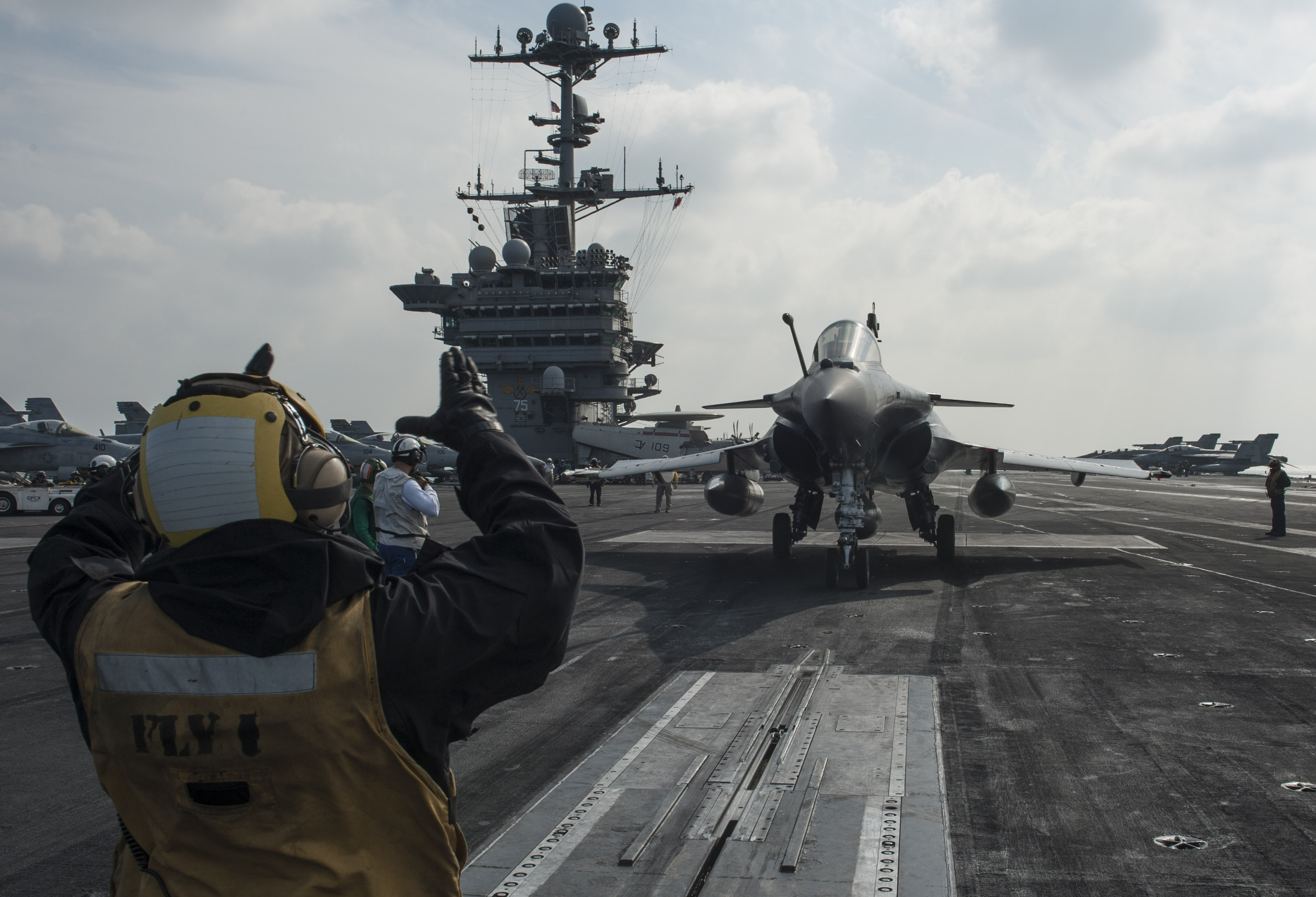
Cmdr. Marc, commander of the French carrier airwing training at Naval Air Station Oceana. USNI News photo
NAVAL AIR STATION OCEANA, Va. — Since carrier flight skills atrophy over time, French naval aviators are spending two months training with US Navy air wings so they’ll be ready for missions this summer when their carrier FS Charles de Gaulle (R91) finishes repairs after almost two years in the yard.
For almost a month, passersby at the Virginia Beach oceanfront have caught glimpses of French Navy Dassault Rafale M fighters fighter jets thundering into the air and out to sea from Naval Air Station Oceana.
While the 35,000-ton Charles de Gaulle completes a major 18-month overhaul, about 350 French Naval aviators, flight deck crew and maintenance personnel flight line crew are now undergoing carrier training in Virginia Beach and are scheduled to perform carrier qualifications aboard USS George H.W. Bush (CVN-77) in May.
“Pilots, most of them are very experienced, but 18 months without doing something is a long time,” Cmdr. Marc, the French airwing commander, said while talking to a small group of reporters on the flight line at Oceana, as members of his squadron flew exercises. Citing security concerns, French Navy officials asked to be identified using first names only.

French Rafale fighter at Naval Air Station Oceana. USNI News photo
Working alongside U.S. Navy personnel, though, is not so foreign to the French aviators, Marc said. France sends its naval aviators to Mississippi, where they learn how to land on and fly off carriers in the same courses and with the same training jets used by the U.S. Navy. From an operational standpoint, Marc said it’s easy to integrate into the U.S. Navy airwing’s operation.
“What’s nice is we have a common baseline in that their pilots go to U.S. flight school. The Rafale and E-2 pilots start their training here in the United States and continue their training in France,” Capt. Jim McCall, the commander of Carrier Air Wing 8, told USNI News.
“So what we’ve done here is fully integrated here into our air wings.”
Charles de Gaulle has been a steady presence in the fight against ISIS. Before going into the yard, the carrier deployed three times to the Middle East. In December 2015, during a gap in U.S. carrier presence in the region, Charles de Gaulle served as the flagship for U.S. Naval Forces Central Command Task Force 50.

Captain James McCall III, right, commander, Carrier Air Wing (CVW) 8. US Navy Photo
During operations aboard George H.W. Bush in May, McCall said, the plan is for the French personnel to seamlessly join regular carrier operations, which includes flying with U.S. aircraft and performing flight deck duties with their U.S. counterparts.
“They’re actually going to plug and play into our airwing like they’re a U.S. squadron,” McCall said. “They’re going to integrate into our air plans and our methodologies out aboard the ship. They’re going land like we land, they’re going to come aboard the ship like we do, they’re going fly the same cycle times we do.”
The French E-2C Hawkeye aircrews will fly with and in U.S. Navy Hawkeyes, Airborne Early Warning Squadron (VAW) 124 commander Cmdr. Christian Goodman told USNI News. The French E-2C airframes are the same as those used by the U.S., and the two nations’ E-2C pilots go through the same training. When Goodman was in flight school, he said, one of his instructors was a French E-2C pilot. When on Bush, Goodman said they’ll operate as one squadron.
“There’s no learning,” Goodman said. “Now it is really about sharing knowledge with each other about how to operate an aging aircraft.”

The aircraft carrier USS Carl Vinson (CVN-70), left, and the French nuclear aircraft carrier Charles de Gaulle (R91) transit the Northern Arabian Gulf on March 8, 2015. US Navy Photo
Flying with and sparring against the Rafale in exercises have been extremely valuable for the F/A-18E Super Hornet pilots in Strike Fighter Squadron (VFA) 31, squadron commander Cmdr. Kevin Chlan told USNI News. Usually his squadron practices against other Super Hornets, but he said it’s been interesting learning how the French tackle missions, arriving at the same end result but using different tactics that draw on the Rafale’s strengths,
“The Rafale is an impressive aircraft,” Chlan said.
“When you go up and fight against it, it’s a little rocket ship.”
The Rafale entered service with the French Navy in 2002, shortly after the F/A-18E/F Super Hornet entered service with the U.S. Navy in 1999. Both are designed for carrier operations, and both can reach a maximum speed of Mach 1.6. But the Rafale is a lighter and carries different weapons.

A Sailor guides an F-1 Rafale, attached to the French aircraft carrier Charles de Gaulle, to a catapult for launch on the flight deck of the aircraft carrier USS Harry S. Truman (CVN-75) in 2014. US Navy Photo
The closest comparison in the U.S. is probably the F-16 Fighting Falcon, Chlan said. Originally developed by General Dynamics and now built by Lockheed Martin, the F-16 is used by the U.S. Air Force and more than two dozen foreign air forces.
“The French are great partners. We see them in the skies, we operate alongside them, but we don’t really interact with them. Here we’re actually getting the chance to talk, and to brief, and plan for a flight,” Chlan said.
“I’ve been in the Navy for 18 years and I’ve never had a chance to do something like this.”
